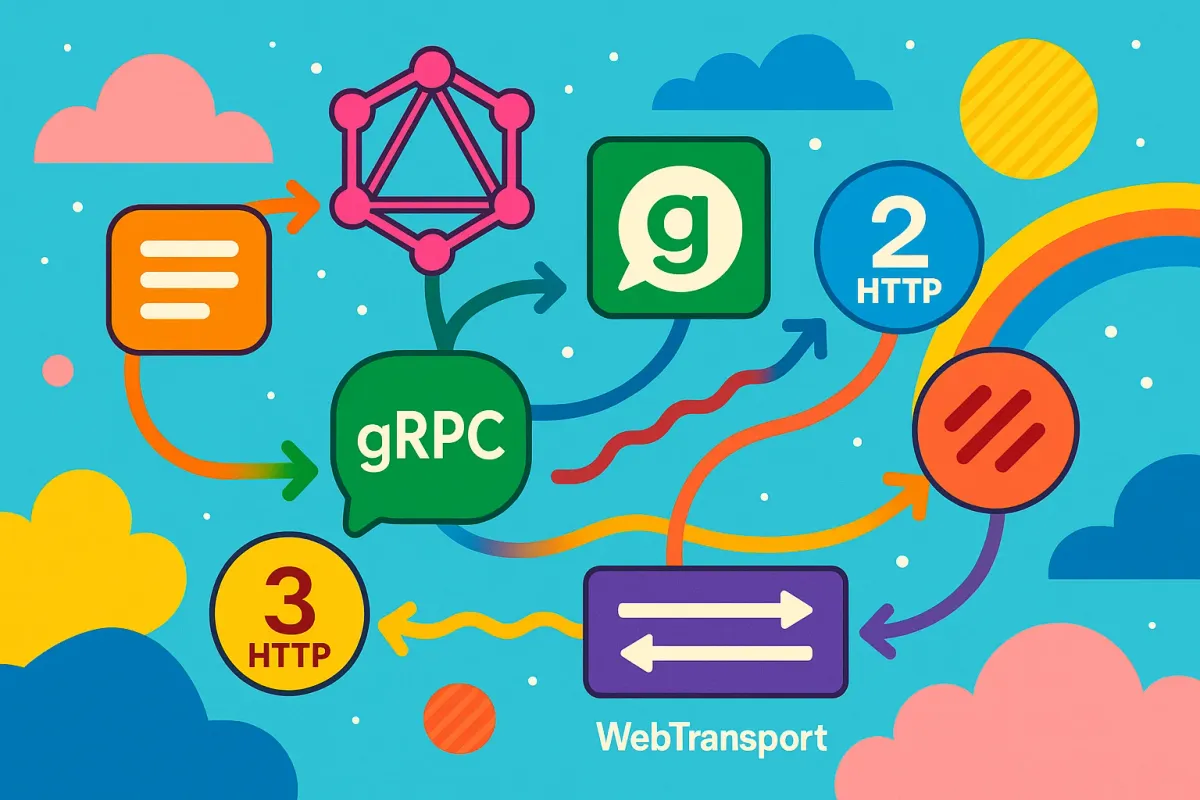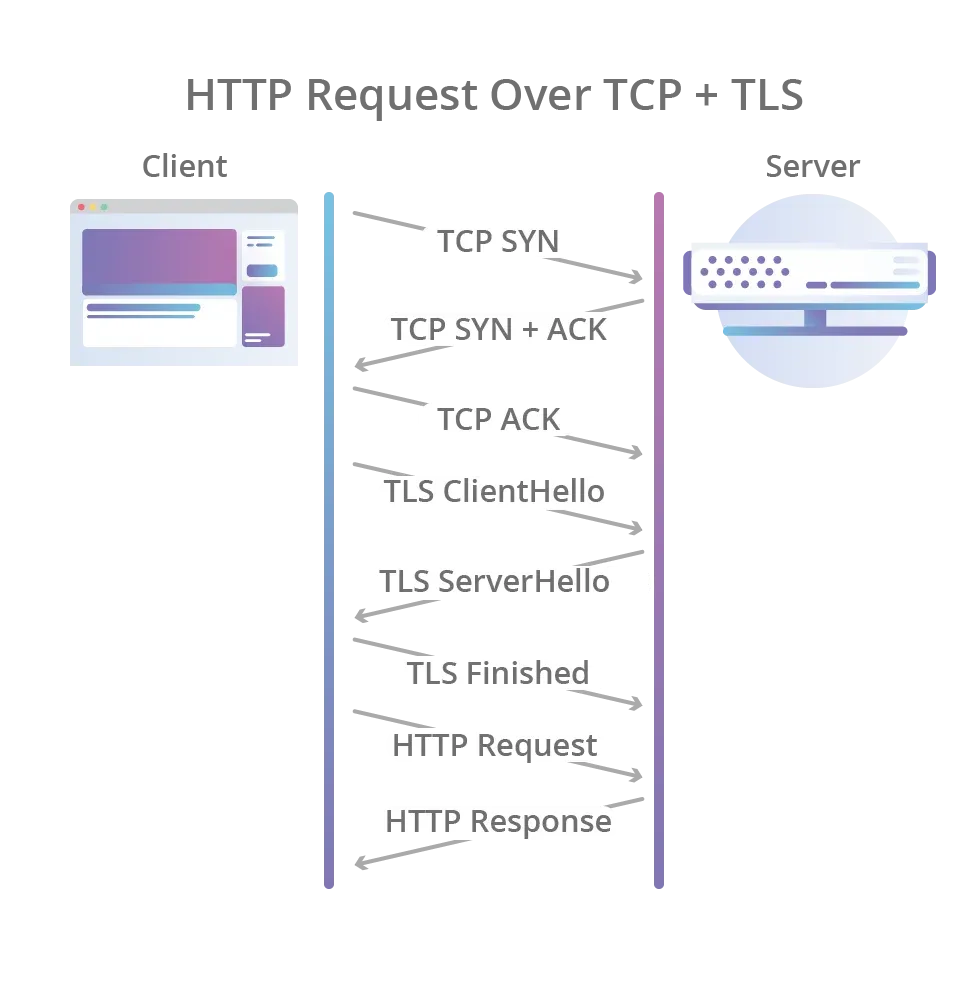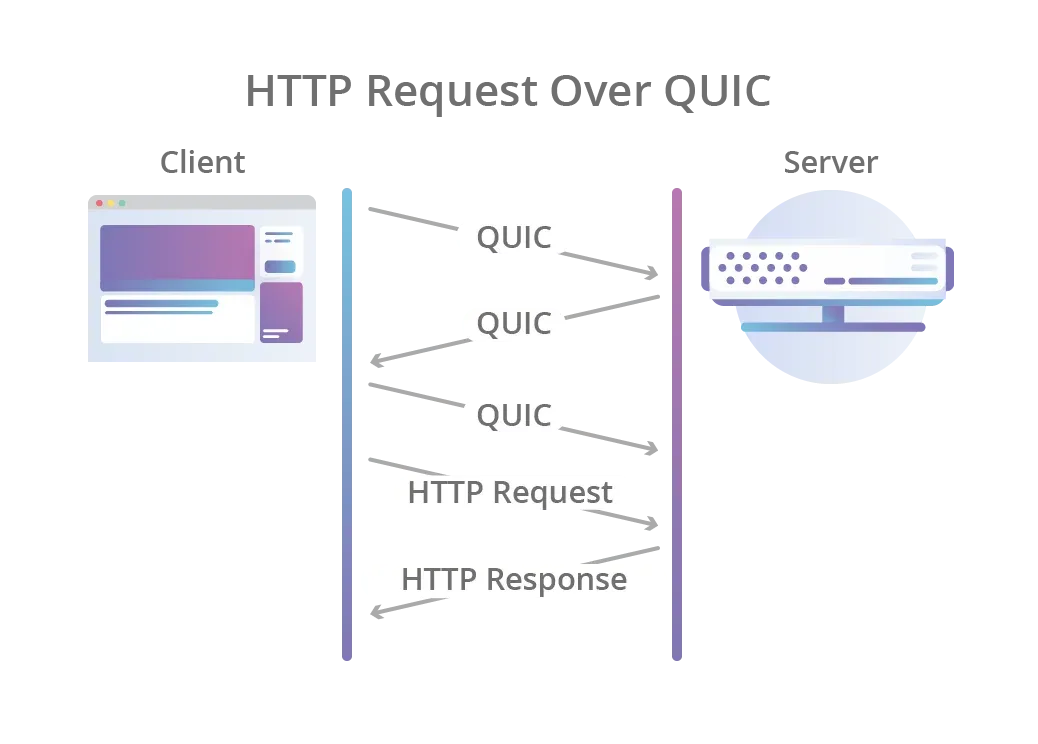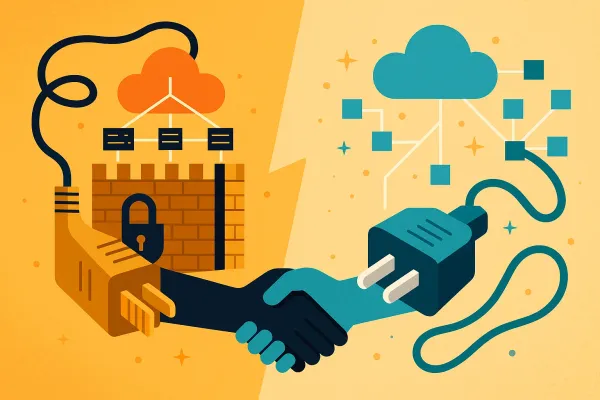Choosing the Right Communication Protocol in 2025: gRPC, Traditional HTTP, and the Evolving Landscape
The post explores modern communication protocols—REST, GraphQL, gRPC, HTTP/2, HTTP/3, Protocol Buffers over HTTP, and WebTransport—offering practical recommendations for backend, frontend, and API layers, examining tradeoffs in performance, compatibility, and maintainability.

In the dynamic world of software development, the choice of communication protocol is a foundational decision. While HTTP (in the form of REST and GraphQL) has long reigned supreme, the rise of gRPC has presented a compelling alternative, particularly for performance-critical applications. Now, the HTTP landscape itself is evolving, offering new options that aim to bridge the gap between traditional HTTP and gRPC. This comprehensive post explores when to choose gRPC, traditional HTTP, and these exciting new HTTP-based approaches at various layers of your application stack.
The Contenders: A Modern Overview
Let's refresh our understanding of the key players in this space:
- HTTP (REST/GraphQL): The bedrock of web communication. REST provides a stateless architectural style, while GraphQL offers a flexible query language for APIs, both typically relying on JSON.
- gRPC: A high-performance RPC framework from Google, leveraging Protocol Buffers for serialization and HTTP/2 for transport.
- HTTP/2 & HTTP/3: Evolved versions of HTTP that bring significant performance improvements through features like multiplexing, header compression, and (in the case of HTTP/3) a UDP-based transport.
- Protocol Buffers over HTTP: A strategy to utilize the efficient serialization of Protocol Buffers with standard HTTP requests, offering some of gRPC's performance benefits without the full framework.
- WebTransport: A new browser API enabling bidirectional, multiplexed streams over HTTP/3, facilitating more gRPC-like communication patterns in web applications.
When to Choose Which Protocol
The optimal choice depends on the specific context and requirements of your application layer.
1. Inter-service Communication (Backend Microservices):
- gRPC: Still a strong contender for high-performance, low-latency communication with strongly typed contracts and built-in code generation. Ideal for internal services where performance is critical.
- HTTP/2 & HTTP/3: Offer significant performance improvements over HTTP/1.1, making them viable options for inter-service communication, especially if you prefer the familiarity and wider tooling of standard HTTP.
- Protocol Buffers over HTTP: A good middle ground if you need the performance benefits of Protocol Buffers but want to retain the flexibility of standard HTTP without the full gRPC framework.
2. Client-to-Server Communication (Frontend Applications):
- HTTP (REST/GraphQL): Remains the dominant choice for web browsers due to native support and a mature ecosystem. GraphQL is particularly advantageous for efficient data fetching.
- gRPC: Suitable for native mobile and internal desktop applications where performance is paramount. Consider the BFF pattern when serving web frontends.
- WebTransport: A promising option for building more real-time and bidirectional communication patterns in web applications, potentially reducing the need for
grpc-webin some scenarios.
3. Public APIs:
- HTTP (REST/GraphQL): Remains the standard for public-facing APIs due to universal interoperability, extensive tooling, and established security infrastructure.
The Evolution of HTTP: Bridging the Gap
The emergence of HTTP/2, HTTP/3, and related technologies is blurring the lines and offering new ways to achieve performance and efficiency within the HTTP ecosystem.
- HTTP/2 and HTTP/3: Performance and Efficiency: These protocols address the performance limitations of HTTP/1.1 by introducing features like multiplexing (sending multiple requests and responses over a single connection), header compression (reducing overhead), and server push (proactively sending resources). HTTP/3's use of QUIC over UDP further enhances reliability and reduces latency, especially in mobile environments.


Image Credits: Cloudflare
- Protocol Buffers over HTTP: Performance with Flexibility: By choosing to serialize data with Protocol Buffers in your HTTP requests and responses, you can achieve significant performance gains in terms of speed and bandwidth usage compared to JSON. This allows you to leverage the efficiency of Protocol Buffers within a standard HTTP framework, giving you more control over your API design.
- WebTransport: Real-time Communication in the Browser: WebTransport opens up new possibilities for building real-time applications in the browser. Its support for bidirectional, multiplexed streams over HTTP/3 allows for low-latency communication that is well-suited for scenarios like live updates, gaming, and media streaming, potentially offering a more efficient alternative to WebSockets in some cases.
sequenceDiagram
participant Client
participant Server
Note over Client,Server: Step 1: Establish WebTransport session
Client->>Server: HTTP/3 CONNECT request to /wt endpoint <br/> (This initiates the QUIC + TLS 1.3 handshake)
Server-->>Client: HTTP 200 OK response <br/> (Session is now established)
Note over Client,Server: Step 2: Use Streams and Datagrams
%% Bidirectional Stream Example %%
Client->>Server: Opens a bidirectional stream and sends data
Server-->>Client: Sends response on the same stream
%% Unidirectional Stream Example %%
Server->>Client: Opens a unidirectional stream and sends data
%% Datagram Example %%
Client->>Server: Sends unreliable datagram
Server->>Client: Sends another unrelated datagram
Note over Client,Server: Step 3: Close session
Client->>Server: Closes the session (e.g., closing the connection)
Server-->>Client: Acknowledges closure at the transport layerWebTransport streaming session flow
Tradeoffs: A Broader Comparison
Let's expand our comparison table to include these new options:
| Feature | gRPC | REST/GraphQL (over HTTP/2, HTTP/3) | gRPC-Web | WebTransport | Traditional REST/GraphQL (over HTTP/1.1) |
|---|---|---|---|---|---|
| Transport Protocol | HTTP/2, with experimental/growing support for HTTP/3. | HTTP/2, HTTP/3 | HTTP/1.1, HTTP/2 (requires proxy) | HTTP/3 (specifically over QUIC) | HTTP/1.1 |
| Serialization Format | Protocol Buffers (mandatory) | Typically JSON, but can use any format (e.g., XML). | Protocol Buffers | Any format; operates on byte streams. | Typically JSON, but can use any format (e.g., XML). |
| Code Generation | Yes, core feature for client/server stubs from .proto files. |
Optional, via tools like OpenAPI Generator or GraphQL Code Generator. | Yes, core feature, generates client code that translates to HTTP. | N/A (low-level API) | Optional, via tools like OpenAPI Generator. |
| Strong Typing | Yes, via .proto service definition files. |
Optional, via schemas like OpenAPI or GraphQL Schema Definition Language (SDL). | Yes, via .proto files. |
No, works with raw byte streams; typing is user-defined. | Optional, via schemas like OpenAPI or GraphQL Schema Definition Language (SDL). |
| Multiplexing | Yes, inherent from HTTP/2. | Yes, inherent from HTTP/2 & HTTP/3. | Depends on the proxy and connection to the gRPC backend. | Yes, inherent from HTTP/3. | No, subject to head-of-line blocking. |
| Header Compression | Yes (HPACK/QPACK) | Yes (HPACK/QPACK) | Yes | Yes (QPACK) | No |
| Streaming | Yes (unary, server-streaming, client-streaming, bidirectional) | Server-streaming possible (e.g., Server-Sent Events), but not native bidirectional. | Server-streaming and unary calls. Bidirectional streaming is not supported. | Yes (bidirectional and unidirectional streams). | No (typically requires WebSockets as a separate solution). |
| Browser Support | No (requires gRPC-Web proxy) | Excellent | Excellent (works in all modern browsers) | Good and Improving (supported in Chrome, Edge, and Firefox). | Excellent |
| Primary Use Case | High-performance internal microservice communication. | General-purpose web APIs, public-facing services. | Making gRPC services accessible from web browsers. | Low-latency, client-server messaging like gaming, live streaming. | Legacy systems, simple public APIs where performance is not critical. |
Common Failures in gRPC Adoption
Teams attempting to adopt gRPC often encounter similar challenges. Being aware of these pitfalls can help you navigate the adoption process more smoothly.
1. Technical Challenges:
- Underestimating Browser Limitations: Forgetting that direct gRPC usage in browsers is limited and requires
grpc-weband a proxy can lead to significant roadblocks. - Complexity of Initial Setup: Setting up gRPC with necessary features like TLS and load balancing can be more involved than with HTTP.
- Serialization and Schema Evolution Issues: Poorly defined
.protocontracts or a lack of understanding of schema evolution rules can lead to integration problems and breaking changes. - Debugging Difficulties: The binary nature of Protocol Buffers can make debugging more challenging without the right tools.
- Misconceptions about Performance: Adopting gRPC solely for performance without understanding the actual bottlenecks might not yield the desired results.
- Load Balancing Complexities: Traditional HTTP load balancers might not be optimal for gRPC's HTTP/2 connections.
2. Organizational and Team Challenges:
- Lack of Team Expertise: Insufficient training and onboarding for gRPC can lead to errors and delays.
- Ignoring Existing Infrastructure: Trying to force gRPC into an incompatible infrastructure can create friction.
- Poorly Defined API Contracts: Even with
.protofiles, a lack of clear API design principles can hinder maintainability. - Communication Breakdown: In microservice environments, poor communication between teams regarding gRPC service changes can cause integration issues.
3. Architectural Challenges:
- Over-engineering for Simple Use Cases: Using gRPC for very basic communication might introduce unnecessary complexity.
- Not Considering the Entire Ecosystem: Failing to plan how gRPC integrates with other essential components like logging and monitoring can lead to operational challenges.
- Mismatch with Certain Scenarios: Trying to use gRPC for all types of APIs, including public-facing ones, might not be the most effective approach.
While the HTTP landscape evolves, the common pitfalls of adopting gRPC remain relevant for those choosing that path. Remember to consider browser limitations, setup complexity, schema management, debugging, load balancing, and the need for team expertise.
Conclusion: A More Nuanced Decision
The choice of communication protocol in 2025 is more nuanced than ever before. While gRPC continues to be a powerful option for specific scenarios, the advancements in HTTP with HTTP/2, HTTP/3, Protocol Buffers over HTTP, and WebTransport offer compelling alternatives that bring many of the performance and efficiency benefits of gRPC to the more widely adopted HTTP ecosystem.
graph TD
subgraph "Client Tier"
direction LR
Client["Web/Mobile Client"]
end
subgraph "Gateway Tier"
direction LR
APIGateway["API Gateway"]
end
subgraph "Service Tier"
direction TB
UserService["User Service"]
OrderService["Order Service"]
ProductService["Product Service"]
NotificationService["Notification Service"]
end
subgraph "Data Tier"
direction TB
UserDB[("User DB")]
OrderDB[("Order DB")]
ProductDB[("Product DB")]
end
%% Define Connections
Client -- "HTTP/3" --> APIGateway
APIGateway -- "HTTP/3 (REST API)" --> UserService
APIGateway -- "HTTP/3 (REST API)" --> OrderService
OrderService -- "gRPC (Unary Call for Product Info)" --> ProductService
OrderService -- "gRPC (Client Streaming for Notifications)" --> NotificationService
%% Service to Database Connections
UserService --- UserDB
OrderService --- OrderDB
ProductService --- ProductDB
%% Styling
classDef default fill:#2d3436,stroke:#b2bec3,stroke-width:2px,color:#dfe6e9;
classDef db fill:#636e72,stroke:#b2bec3,stroke-width:2px,color:#dfe6e9;
class Client,APIGateway,UserService,OrderService,ProductService,NotificationService default;
class UserDB,OrderDB,ProductDB db;
linkStyle 0 stroke:#0984e3,stroke-width:2px;
linkStyle 1 stroke:#00b894,stroke-width:2px;
linkStyle 2 stroke:#00b894,stroke-width:2px;
linkStyle 3 stroke:#d63031,stroke-width:3px,stroke-dasharray: 5 5;
linkStyle 4 stroke:#e17055,stroke-width:3px,stroke-dasharray: 3 3;An example architecture utilizing a mix of gRPC and HTTP/3
Ultimately, the best approach involves carefully evaluating the specific requirements of each layer in your application, considering factors like performance needs, browser compatibility, developer familiarity, and long-term maintainability. By understanding the strengths and weaknesses of each option, you can make informed decisions that lead to a more robust, efficient, and scalable application in the modern web landscape.



